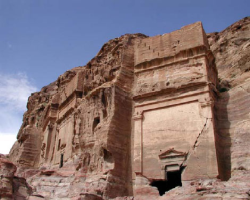|

Dr Lucy Wadeson (University of Oxford & CBRL Fellow)
The ancient geographer Strabo relates that the Nabataeans at Petra treated their dead like dung, and even buried their kings beside dung-heaps (Geog. 16.4.26). These statements do not accord with the magnificent tombs carved in Petra’s rocky landscape and the few burial remains that have been recovered. Nevertheless, very little is known about the burial practices and funerary ritual associated with the tombs, due to a loss of evidence from looting and reuse of the chambers over the centuries. Documentation and study of the rock-cut architecture, both behind and in front of the façades of the tombs, have been taking place since 2005, with the aims of enhancing knowledge of funerary customs and the debated chronology of the tombs. In this lecture, some new ideas will be presented on the sorts of activities taking place at the tombs and their significance for our understanding of the social and cultural identity of the Nabataeans. It will be demonstrated how the notions expressed in Nabataean funerary inscriptions accord with the archaeological evidence, shedding light on how the Nabataeans conceptualized funerary space. New findings and results from the excavation of Tombs 779 and 781 at the base of el-Khubtha will also be presented, including an entirely new burial structure and information on the functioning of tomb complexes.
|